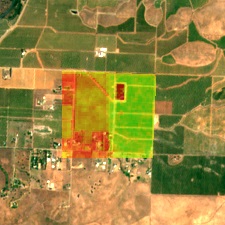NDVI vs NDRE And Their Applications In Agriculture
NDVI (Normalized Difference Vegetation Index) and NDRE (Normalized Difference Red Edge) are known as “index products” which are primarily used to estimate crop health in an agricultural field. Both of these indexes are constructed from a combination of two distinct frequencies of light. NDVI is built with a combination of visual red light and near-infrared (NIR) light. NDVI is discussed in detail in a separate article. You can read the detailed article on this link below:
https://farmonaut.com/blogs/remote-sensing/normalized-difference-vegetation-index-ndvi/
NDRE uses a combination of near-infrared light and a frequency band that is in the transition region between visual red and NIR light.
One of the most common question being asked is NDVI or NDRE, which one should I use? And what we say to this is that it depends upon the growth stage of your crops in the farming field.
NDVI is a more commonly used index to estimate crop health of a given field. In simple words, NDVI correlates with chlorophyll, which then in turn correlates with plant health. Having NDVI information of a particular field can help us identify crop health in their earlier growth stages.
However, it isn’t perfect and accurate for all crops and for all stages of crop growth. The visual-band red content is absorbed quite strongly by the top of the plant canopy, which means that the NDVI measurements do not have contribution from the lower levels of the canopy. Hence, leaf area index (LAI) and its correlation with NDVI is partially impaired. If the plants have more layers of leaves (for example, tree canopies), this impairment of correlation of LAI with NDVI increases.
Furthermore, in grasses, cereal crops, permanent crops and in certain row crops which are in their later growth stages, chlorophyll content reaches a point at which NDVI reaches a maximum value of 1.0 and hence saturates. Hence, any crop health issue is hard to detect with NDVI until any such problem becomes strong enough to reduce the NDVI value below 1.0. This may happen at a point at which damage has already occurred.

NDRE OFFERS A SOLUTION
By substituting NDVI’s red band with NDRE’s red edge band we can mitigate this issue of saturation discussed abovev. NDRE’s red edge band provides a measurement that is not as strongly absorbed by just the topmost layers of leaves. By using NDRE, one can get better insight into crops in their later stage because it is able to observe further down into the canopy as well.
NDRE = (NIR – RE)/(NIR + RE)
NDRE is also less prone to saturation in the presence of dense vegetation. This will help us get much accurate results in pasture biomass estimation measurements. Thus, in situations like these, NDRE can provide a much accurate and better measurement of variability in an area in which the NDVI measurement would come simply as 1.0
So, in conclusion, if the crops of observation are permanent or dense, you should use NDRE right away. Ofcourse, using both the indices together is often the most ideal solution. A lot of farmers with crops that transition from seed to thick canopies in a single season make use of both NDVI and NDRE.
Farmonaut’s Automated Satellite Based Crop Health Monitoring System provides a farmer with both NDVI and NDRE results for crop health status measurements everytime the satellite crosses the farmer’s field.

We will keep posting about any such informative information on to our blogs, to help as many people as possible. Farmonaut is built upon a vision to bridge the technological gap between farmers and strives to bring state-of-the-art technologies in the hands of each and every farmer. For any queries/suggestions, please contact us at [email protected].
We have some more interesting articles coming up soon. Stay tuned!
Wait!!
Before that…



























